

|
| Elliott Sound Products | Counterfeit Semiconductors - 1 |
 Main Index
Main Index
 Counterfeits Index
Counterfeits IndexBeware of MJ15003 and MJ15004 transistors in aluminium cases (genuine Motorola [now On-Semi] devices use steel cases, and have done since 1982). Don't count on this, though - there are fake Motorola devices in steel cases too. I suggest that you test the markings with a solvent (such as acetone - nail polish remover). Most genuine transistors are marked with non-removable ink, counterfeit devices may be marked with normal screen printing ink that comes off easily.
Test the breakdown voltage with a transistor tester if one is available. Genuine devices are rated at 140V, but will usually be higher than this. Counterfeit transistors will generally have a much lower breakdown voltage. Be warned that the latest batch of fakes will actually pass this test !
Always ask for confirmation from the supplier that the devices are genuine. Feel free to refer them to this page if they claim you are mad. 
Some time ago, I asked one of the local suppliers (who was inadvertently selling counterfeit devices) to check the authenticity of their stock. I will not name the supplier(s), as it is quite probable that they are innocent, and have been defrauded along with everyone else. Needless to say, I cannot do this checking with any supplier outside Australia, as I do not have ready access to the components they sell or to anyone who might know something.
This Australian supplier had a 'Stop Sale' on their computer for these devices, so it has been noticed by them, at least. In particular, look for a manufacture code of MEX190, with the date code 9H34. Some of the counterfeit devices even have the wrong polarity (an NPN MJ15004 - I don't think so!).
Double Headed Duds!
I have been advised that the frauds - or at least some of them - have two transistor silicon dies internally, wired in parallel in a desperate (but futile) attempt to meet the specifications. These are both quite small for the claimed power rating, and are directly bonded to the steel case. The use of two dies is in itself most unusual, but they are not even bonded to a copper heat spreader as is the normal practice, so thermal transfer will be much worse than it should be, and thermal expansion coefficients possibly place the silicon at much greater risk of cracking - not from anything the user does, but from normal heating and cooling cycles.
I managed to convince the salesperson at an electronics outlet to sell me one of the 'MJ15003' devices, despite the 'stop sale' warning from the computer. This is fine, since I already explained why I wanted one. Most discouraging was that the salesperson obtained 'advice' from someone else in the store that the one I had (MEX190) was genuine. Well, excuse me. There were some others in the drawer that looked as if they might be real Motorola devices, but not these.
I got it home, and promptly ran some tests before I cut the top off. Gain was (barely) passable at 25 at 0.5A, and the breakdown voltage was above the 140V rating. Then I removed the top, and guess what I found? If you said "Two dies?", you are quite correct. They are exactly as described to me - two small dies, bonded directly to the steel case, and wired in parallel with what I thought were rather flimsy bonding wires. The whole construction was coated with a thin layer of silicone.
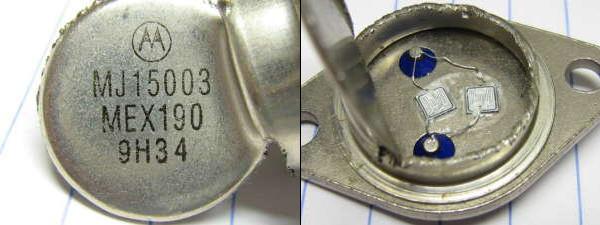
Here Are The Two Dies, In All Their Glory!
Given the sophistication of this fraud, it seems more than likely that these transistors are made in a proper fabrication plant, rather than just being relabelled junk or factory rejects. The construction overall (of my sample at least) was quite neat, and was obviously performed with the proper equipment - if I were to go to that much trouble, it would be worth the effort to use the correct die in the first place! This begs the question of where they come from, and I for one would be very interested to find out. From the latest information to hand, China and India are implicated.
One way to be sure that you have the real thing is to buy ONLY from accredited and authorised Motorola or Toshiba (or whomever) distributors. This may be irksome for home constructors, as these dealers usually have a minimum order value (locally it is AU$100 but will vary in different countries). It is not known at this stage how widespread the rort is, but since I have (over the last few years) received information from the UK, USA, Canada, New Zealand, Sweden and India about similar rackets, we can justifiably assume that no-one is safe. If anyone has further information to add, please e-mail me.
Some info received from a local supplier in response to my e-mail (reproduced verbatim) ...
Dear Mr. Elliott,
Thank you for your email regarding the above matter. We have already been alerted to the problem about a couple of weeks ago when it was first noticed that some of the MJ15004 were found to be incorrectly polarised - that is, NPN instead of PNP. Our suspicions were raised and we proceeded to cut the devices open, finding their internal construction to be as per your description. Not only that, the chip dies were smaller than the known genuine Motorola types and the internal finishing was abysmal - not the usual high standards that is expected of a Motorola device. The counterfeiters were, fortunately, not too professional and it was possible, on close inspection and comparison to a genuine Motorola device, to tell them apart.
From our knowledge of Motorola manufacturing processes, such a shoddy quality would never have been passed and they are definitely not from Motorola. Upon ascertaining this, we contacted Motorola or rather, ON Semiconductors in the U.S. and notified them of the counterfeits. Together with that, we also provided them with whatever information we have on hand regarding the source trail of our stock which came through a local Australian importer who brought them in through an until-now trusted source in Hong Kong. We have little to doubt the trustworthiness of our supplier as we have been dealing with him for a number of years without any problem encountered. From ON Semiconductor's reply, it would appear that they are already aware of the existence of a counterfeit ring operating out of India and China. We have left any further investigations that ON Semiconductors may want to carry out with them on an international level.
There was some more information regarding store policies that I shall not disclose, since this may identify the supplier to locals, at least. I was suitably impressed with the explanation and the efforts taken to fix this problem, and can only hope that other suppliers are equally responsive.
Oct 2000 - Dick Smith Electronics Issues 'Motorola' Recall Notice
Australian electronics retailer (and wholesaler) Dick Smith Electronics has issued a recall notice on the fake Motorola transistors, and provides a detailed description of how to identify the genuine article from the frauds. This is a good move, and offers some hope to the poor purchaser, however so far no-one else has even acknowledged that this fraud exists, despite that fact that at least one Sydney based firm is still happily selling the counterfeit devices. This is a shameful situation, and one that I would like to see corrected as soon as possible. I am not about to hold my breath, as I expect it will be a long time (if ever) before the others admit their mistake (assuming that it actually was a mistake!)
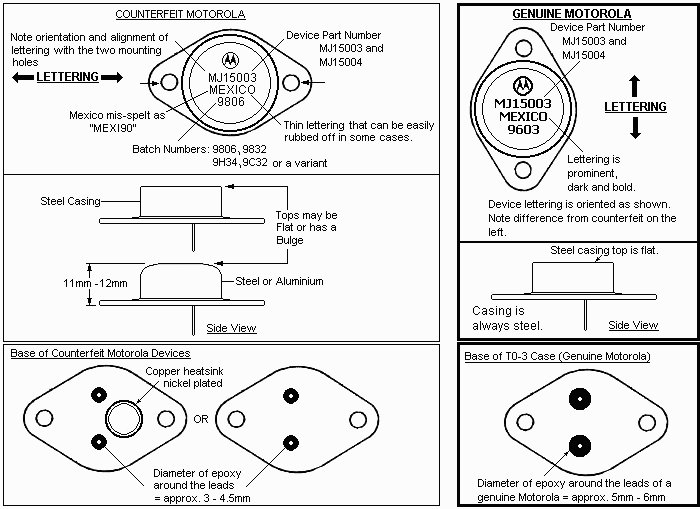
Finally, click either image below to enlarge - they are fairly big photos, and will take a while to load if you are on a dial-up connection. It is worth the effort though, just so you can see some real samples.
From South Africa ...
I live in South Africa and build audio stuff for a hobby (sometimes making the odd amp for a friend and I am presently finishing a friends amp.) I was surfing the web and stumbled onto your site again. Having looked through all the project stuff, I finally went onto the editorials and came across the counterfeit transistor story.
The hairs on the back of my neck started to rise the more I read because the amp that I am finishing is using MJ15003/15004 output devices, but I was at work and had to wait till I got home to check what devices I have installed in the amp. Needless to say they seem counterfeit, see attached jpeg image file, with MEX190/MEX1CO as the place of manufacture and 9H34/9R32 as the date codes (as per Richard Freeman's email to IndustryCommunity.com). I have as yet to open these device but I am sure that they will have two dies internally, when I get the time I will open them and take a photo of the internals. So the counterfeit devices are not only confined Australia, but are probably available throughout the world.
The JPEG image I was sent later confirmed the devices are fakes. They were virtually identical to those shown above.


Some Examples of Genuine ON-Semi / Motorola Transistors
Note the size of the die in the left-most transistor. It about right for a 2N3055, but much too small for anything else. How easy is it for a counterfeiter to remove the part number and replace it? Given the price difference, it's well worth someone's time to make the switch - there is a potentially very large profit to be made for a minimum of effort.
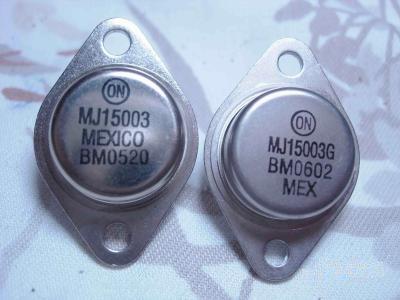
Left Image - Counterfeit, Right Image, Genuine
There is a fair amount of difference to tell them apart. The 'G' suffix (on genuine devices) indicates they are lead-free to conform to European RoHS regulations. The main thing to look for is 'MEXICO' followed by the date code, where the genuine devices have the date code followed by 'MEX'.
 |
The latest ON-Semi data sheet shows the official marking scheme. The image shown is taken from the On-Semiconductor data sheet, and shows the layout clearly. Both transistors pictured appear to use two characters for the location code, while the data sheet indicates that only one letter is used. I don't know the specifics (and there isn't much I could find to help), so maybe this is normal, maybe not. All I can suggest is that anyone finding any of these devices (regardless of markings) should be suspicious. As seen above, the MJ15003/4 has been the target of counterfeiters for quite some time, and I suggest that unless you get them from an accredited (and official) distributor, you are more likely to get fakes than genuine parts. Sad, but true. |
I have just been advised that the device in the left image (the fake) fails the acetone test, and the markings come off quite easily. Needless to say, the genuine part is not affected. The seller of these fakes in Brazil claimed to have obtained them from an authorised distributor - not likely! Any authorised distributor who deals with anyone other than the manufacturer will very quickly be 'de-authorised' by the maker. This is the only way that fakes can be eliminated from the supply chain, but unfortunately there are too many unscrupulous people who will cheerfully put profit before anything else.
It's worth noting that the above info appears to contradict the earlier photos and the pamphlet distributed by Dick Smith. Yes, there is confusion and contradiction, but it's not me - blame the manufacturers. In some respects they are our enemy because they won't do anything at all to help. The images shown indicate one thing only - no marking scheme is a guarantee. It obviously changed since the earlier problems, but trying to keep track is impossible.
A good part of the whole problem is that the genuine makers do not follow a consistent scheme, change things when they feel like it and most often completely fail to provide current information about genuine and fake devices to help purchasers. Ultimately, it's left up to people like me to try to maintain some form of identification, but I'm one person, and it's impossible to keep track of all the fakes. Most of the info here is historical - by the time I'm told, countless people have been caught.
On-Semiconductor has an application note (AND8004-D) that explains date and location codes, but it does not cover TO-3 packages. It is notable that the code 'BM' as seen on both devices is not listed, but I don't know if this really means anything. I can only suggest that potential buyers are very careful.
Here are some more fakes. The one on the left was provided to a supplier in Europe as a sample, but when they ordered 2,000 of them, the whole lot looked like that on the right. Needless to say they failed when a customer tried to use them, and an investigation revealed the substitution. Why did this supplier purchase parts from China? Because many other suppliers were doing the same, and it was impossible to compete on price.
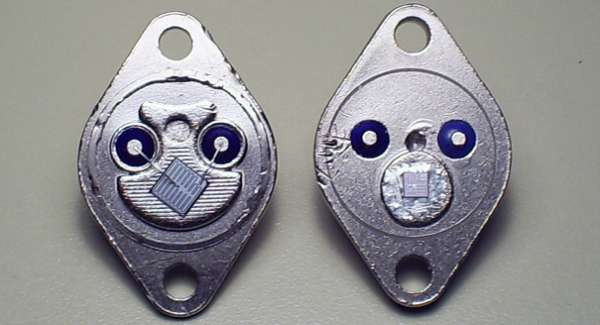
Left Image - Sample, Right Image - Bulk Purchase
Needless to say, this is false economy. High power (and expensive) transistors cost a lot to make, and are tested rigorously by genuine manufacturers who have a reputation to uphold. Counterfeiters prey on those who can't resist a bargain or are looking to make higher profits. They don't care about reputation because they use the reputation of the original company (by using their part numbers and logos).
In my correspondent's own words ...
I was reading your page about the fake transistors that you have encountered so I will try to add my experience to this text:
Few years ago I was working for the electronic parts dealer company here in (location withheld) and when seeing that everybody (competition) started to work with the Chinese we tried to do the same. We contacted Chinese manufacturer of MJ15003 devices that he claimed that he had rights to produce this part in China. We asked for samples and they sent us around 20 MJ15003. I tested them and found that they perform almost as genuine Motorola parts and said to my manager that they are good and to get a 2000 of them (the price was very low). After few weeks the package with the 2000 transistors came and we put them to sale. After few days a customer complained that the transistors may be fake. I talked to him and said that the transistors are made according to the specifications and are quite good but something raised my suspicion. I tested them ... I was shocked when I measured the transistors that came from the big box!!! They were identical in appearance to the samples that I tested earlier but electrically they were totally different!!!
I opened them and I was shocked: You can see the pictures, they talk for themselves. Left image is the sample transistor; the right image is the "stock" one.
The counterfeiters don't give a rodent's rectum if the parts fail in use. They have your money, and that of countless other hapless buyers. When purchasers stop using the supplier because they were caught with fakes, 'Hoo Flung Dung Distribution Pte. Ltd.' becomes 'Gung Ho Distribution Pte. Ltd.' overnight, and the whole process repeats itself ad nauseam.
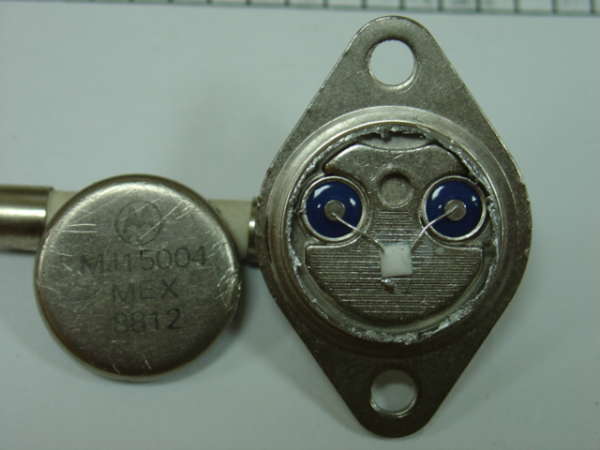
The Latest Photo Sent of a Fake MJ15004 - Note the Tiny Die!
From my correspondent I received the following email ...
I am sending you a photo of MJ15004 which was damaged in PA300 amplifier (from Elektor Electronics, November 1995 issue). The die size is 3x3 mm and epoxy diameter around base/emitter pins is 5mm. The markings can be removed with acetone.
You are welcome to use it on your page about counterfeit power transistors.
I have used 2x MJ15003 and 2x MJ15004 (as per original schematic) and one 15004 and both 15003 were damaged when amplifier was on and then I switched of my preamplifier.
Amplifier was fitted at that time with 3A slow blow fuses on +/- 60V supply rails and both of them blew. All other components are still OK.
Later I found on the scope that there is a sharp spike of at least 0.8 V when the preamplifier is switched off.
However PA300 input sensitivity is specified as 1V and I think that the transistor should not get damaged (all three damaged transistors measure now 0 ohms between all pins).
Both MJ15004 have the same marking (as on the attached photo) and MJ15003's also have MEX but 8807date code.
I bought these transistors in South Africa either at the end of 2003 or beginning of 2004 from Avnet or RS Components (can't remember which one).
I am not sure now which replacement transistors should I buy to avoid fakes (this is quite common here in Dubai, UAE where I stay now).
The preamp switch-off spike is of little consequence - all it should do is make a loud thump through the speaker. Because the fake transistor simply cannot withstand the voltage and current of a transient signal (or any other high level signal for that matter), the output devices simply did what they do best - blow up!
Although the image shows a very substantial heat spreader (which looks much like the original shown above), the die is minuscule! Being so small, it probably would fail if used as a 2N3055.
 Main Index
Main Index
 Counterfeits Index
Counterfeits Index